| Pages:
1
..
42
43
44
45
46
..
76 |
CharlieA
National Hazard
   
Posts: 645
Registered: 11-8-2015
Location: Missouri, USA
Member Is Offline
Mood: No Mood
|
|
You are a busy beaver! Good work.
|
|
|
Noflers
Harmless

Posts: 9
Registered: 14-2-2016
Member Is Offline
Mood: No Mood
|
|
Very nice, Bismuth is definitely my #1 as well. Here's a few of mine. I figure at least one of these phone photos will look good on the big screen.
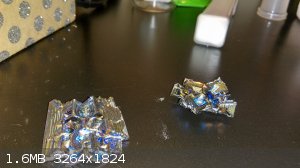 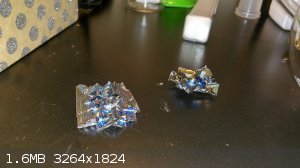 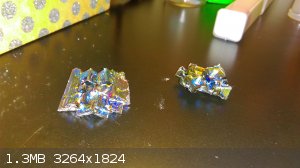 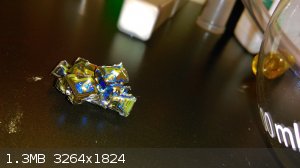 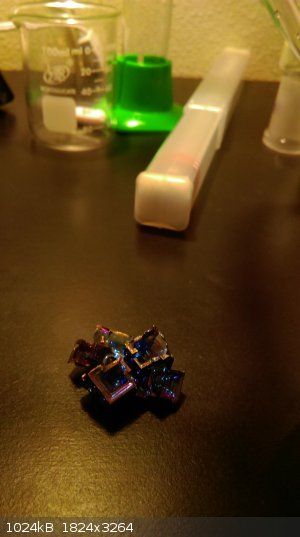 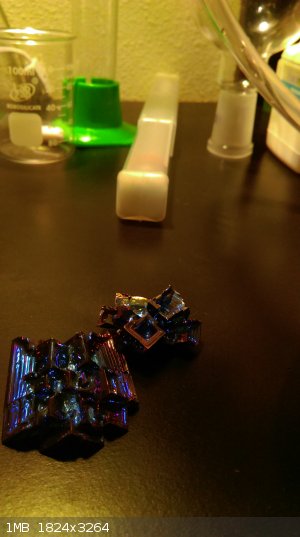
|
|
|
PHILOU Zrealone
International Hazard
    
Posts: 2893
Registered: 20-5-2002
Location: Brussel
Member Is Offline
Mood: Bis-diazo-dinitro-hydroquinonic
|
|
Quote: Originally posted by alexleyenda  | Results of 20 hours of inorg chemistry in my lab classes.
PbCl6(pyr)2, PbI2, recristalised PbI2, (Ni(NH3)6)Cl2, Ni(NH3)4(NO2)2, (tren)Ni(NO3)2, Bn3SnCl, SnCl4(DMSO)2
[Edited on 16-2-2016 by alexleyenda] |
How did you do this one Ni(NH3)4(NO2)2?
Isn't the Ni hexacoordinator? --> Ni(NH3)6(NO2)2?
Like in your Ni(NH3)6)Cl2 and (tren)Ni(NO3)2?
With N2H4, Ni(NO3)2 fixes 3 N2H4 --> Ni(H2N-NH2)3(NO3)2
PH Z (PHILOU Zrealone)
"Physic is all what never works; Chemistry is all what stinks and explodes!"-"Life that deadly disease, sexually transmitted."(W.Allen)
|
|
|
alexleyenda
Hazard to Others
  
Posts: 277
Registered: 17-12-2013
Location: Québec, Canada
Member Is Offline
Mood: Busy studying chemistry at the University
|
|
Haha the Ni(NH3)4(NO2)2 was quite a long process. First, NiSO4 hexahydrate is reacted with KHCO3 to make the carbonate, then acetic acid is added to
form Ni(OAc)2(H2O)4 (both reactions bubble CO2). Then you mix NaNO2 and NH4CH3COO in large excess to make a good NO2 donor (NH4NO2) and add it to the
nickel complex with conc. NH3 (aq) to give Ni(NH3)4(NO2)2. After mixing 10 min at room temp, you let it precipitate for around 3 hours, which gives
the red solid that precipitates out of the blue solution. You must be careful not to add too much water, or the complex will not precipitate.
Metal centers do not always hexacoordinate. I guess the complex is tetrahedric or square planar, which is common when metal centers are d8 (8
electrons in the d orbitals) (search about it, it is very common). For exemple d8 paladium is almost always square planar.
Help us build the Sciencemadness Wiki! Every question and tips about amateur chemistry two clicks away, wouldn't that be awesome?!
sciencemadness.org/smwiki
|
|
|
DraconicAcid
International Hazard
    
Posts: 4278
Registered: 1-2-2013
Location: The tiniest college campus ever....
Member Is Offline
Mood: Semi-victorious.
|
|
Quote: Originally posted by alexleyenda  | Haha the Ni(NH3)4(NO2)2 was quite a long process. First, NiSO4 hexahydrate is reacted with KHCO3 to make the carbonate, then acetic acid is added to
form Ni(OAc)2(H2O)4 (both reactions bubble CO2). Then you mix NaNO2 and NH4CH3COO in large excess to make a good NO2 donor (NH4NO2) and add it to the
nickel complex with conc. NH3 (aq) to give Ni(NH3)4(NO2)2. After mixing 10 min at room temp, you let it precipitate for around 3 hours, which gives
the red solid that precipitates out of the blue solution. You must be careful not to add too much water, or the complex will not precipitate.
Metal centers do not always hexacoordinate. I guess the complex is tetrahedric or square planar, which is common when metal centers are d8 (8
electrons in the d orbitals) (search about it, it is very common). For exemple d8 paladium is almost always square planar.
|
I expect that it is octahedral, with the two nitrites coordinated along with the ammonias. Nitrite is a much better ligand than nitrate (I have a
batch of K4[Ni(NO2)6] on my shelf).
Please remember: "Filtrate" is not a verb.
Write up your lab reports the way your instructor wants them, not the way your ex-instructor wants them.
|
|
|
alexleyenda
Hazard to Others
  
Posts: 277
Registered: 17-12-2013
Location: Québec, Canada
Member Is Offline
Mood: Busy studying chemistry at the University
|
|
Quote: Originally posted by DraconicAcid  | Quote: Originally posted by alexleyenda  | Haha the Ni(NH3)4(NO2)2 was quite a long process. First, NiSO4 hexahydrate is reacted with KHCO3 to make the carbonate, then acetic acid is added to
form Ni(OAc)2(H2O)4 (both reactions bubble CO2). Then you mix NaNO2 and NH4CH3COO in large excess to make a good NO2 donor (NH4NO2) and add it to the
nickel complex with conc. NH3 (aq) to give Ni(NH3)4(NO2)2. After mixing 10 min at room temp, you let it precipitate for around 3 hours, which gives
the red solid that precipitates out of the blue solution. You must be careful not to add too much water, or the complex will not precipitate.
Metal centers do not always hexacoordinate. I guess the complex is tetrahedric or square planar, which is common when metal centers are d8 (8
electrons in the d orbitals) (search about it, it is very common). For exemple d8 paladium is almost always square planar.
|
I expect that it is octahedral, with the two nitrites coordinated along with the ammonias. Nitrite is a much better ligand than nitrate (I have a
batch of K4[Ni(NO2)6] on my shelf). |
It is true that it might be, I did not take time to think about it and made the too rapid asumption that because NO2* is negatively charged it was
only the counter ion, but it can be coordinated too. The nickel is d8 tho, so it "likes" to have a coordination of 4. I'll have to sit and think about
it for longer :p
[Edited on 18-2-2016 by alexleyenda]
Help us build the Sciencemadness Wiki! Every question and tips about amateur chemistry two clicks away, wouldn't that be awesome?!
sciencemadness.org/smwiki
|
|
|
DraconicAcid
International Hazard
    
Posts: 4278
Registered: 1-2-2013
Location: The tiniest college campus ever....
Member Is Offline
Mood: Semi-victorious.
|
|
Quote: Originally posted by alexleyenda  |
It is true that it might be, I did not take time to think about it and made the too rapid asumption that because NO3 is negatively charged it was only
the counter ion, but it can be coordinated too. The nickel is d8 tho, so it "likes" to have a coordination of 4. I'll have to sit and think about it
for longer |
NitrIte, not nitrAte. Nitrate is a lousy ligand; nitrite is a fairly good one.
Nickel(II) is d8, but it will only be square planar with ligands that are strong field splitters (cyanide, or ones like DMG). Apart from low-spin
complexes, it has no more tendency to be 4-coordinate than cobalt(II) or iron(III). With halides, it will form
NiCl4<sup>2-</sup> or NiBr4<sup>2-</sup>, but that's more to do with the size of the halides than the
electron configuration.
Please remember: "Filtrate" is not a verb.
Write up your lab reports the way your instructor wants them, not the way your ex-instructor wants them.
|
|
|
DraconicAcid
International Hazard
    
Posts: 4278
Registered: 1-2-2013
Location: The tiniest college campus ever....
Member Is Offline
Mood: Semi-victorious.
|
|
Copper(II) lactate trihydrate
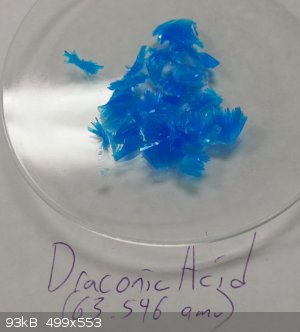
[Edited on 18-2-2016 by DraconicAcid]
Please remember: "Filtrate" is not a verb.
Write up your lab reports the way your instructor wants them, not the way your ex-instructor wants them.
|
|
|
alexleyenda
Hazard to Others
  
Posts: 277
Registered: 17-12-2013
Location: Québec, Canada
Member Is Offline
Mood: Busy studying chemistry at the University
|
|
Quote: Originally posted by DraconicAcid  | Quote: Originally posted by alexleyenda  |
It is true that it might be, I did not take time to think about it and made the too rapid asumption that because NO3 is negatively charged it was only
the counter ion, but it can be coordinated too. The nickel is d8 tho, so it "likes" to have a coordination of 4. I'll have to sit and think about it
for longer |
NitrIte, not nitrAte. Nitrate is a lousy ligand; nitrite is a fairly good one.
Nickel(II) is d8, but it will only be square planar with ligands that are strong field splitters (cyanide, or ones like DMG). Apart from low-spin
complexes, it has no more tendency to be 4-coordinate than cobalt(II) or iron(III). With halides, it will form
NiCl4<sup>2-</sup> or NiBr4<sup>2-</sup>, but that's more to do with the size of the halides than the
electron configuration. |
Well you are right, it makes sense. This inorganic theory is quite fresh for me, I have to really take my time to really think about it and not forget
anything to get to the good conclusion :p And yeah, i'm aware of the difference between nitrate and nitrite as ligands (I just wrote NO3 by mistake),
my error was to forget that it had to be low spin to favorise the coordination of 4. Now the question is on which atom is it coordinated even tho (i'm
not sure but if my memory is good) most of the time it is on the oxygen. I'll have to look at my IR spectrums, maybe tomorrow ^^ Nice cristals by the
way.
[Edited on 18-2-2016 by alexleyenda]
[Edited on 18-2-2016 by alexleyenda]
Help us build the Sciencemadness Wiki! Every question and tips about amateur chemistry two clicks away, wouldn't that be awesome?!
sciencemadness.org/smwiki
|
|
|
PHILOU Zrealone
International Hazard
    
Posts: 2893
Registered: 20-5-2002
Location: Brussel
Member Is Offline
Mood: Bis-diazo-dinitro-hydroquinonic
|
|
Quote: Originally posted by alexleyenda  | Haha the Ni(NH3)4(NO2)2 was quite a long process. First, NiSO4 hexahydrate is reacted with KHCO3 to make the carbonate, then acetic acid is added to
form Ni(OAc)2(H2O)4 (both reactions bubble CO2). Then you mix NaNO2 and NH4CH3COO in large excess to make a good NO2 donor (NH4NO2) and add it to the
nickel complex with conc. NH3 (aq) to give Ni(NH3)4(NO2)2. After mixing 10 min at room temp, you let it precipitate for around 3 hours, which gives
the red solid that precipitates out of the blue solution. You must be careful not to add too much water, or the complex will not precipitate.
Metal centers do not always hexacoordinate. I guess the complex is tetrahedric or square planar, which is common when metal centers are d8 (8
electrons in the d orbitals) (search about it, it is very common). For exemple d8 paladium is almost always square planar.
|
Thank you for the process.
Seems like Cu also form such a complex: Cu(NH3)4(NO2)2
For your Ni complex I thought the NO2 was nitrite anion, but it takes part into the hexacoordinated complex and this explains why two positions are
not available anymore for NH3 ligands.
Those complex may be energetic since NO2 is an oxydiser and NH3 a fuel...
-->Could you test a few mg in contact with a flame?
By experience with Ni(N2H4)3(NO3)2, Cu(N2H4)3(NO3)2, Co(N2H4)3(NO3)2, Ni(NH3)6(NO3)2, Cu(NH3)4(NO3)2, Co(NH3)6(NO3)2, Ni(en)3(NO3)2, Cu(en)2(NO3)2 and
Co(en)3(NO3)2...
The addition of some CH3OH, CH3-CH2OH may help isolation and crystalization from watery solutions followed by washing with ether ((Eth)2O).
PH Z (PHILOU Zrealone)
"Physic is all what never works; Chemistry is all what stinks and explodes!"-"Life that deadly disease, sexually transmitted."(W.Allen)
|
|
|
PHILOU Zrealone
International Hazard
    
Posts: 2893
Registered: 20-5-2002
Location: Brussel
Member Is Offline
Mood: Bis-diazo-dinitro-hydroquinonic
|
|
Quote: Originally posted by wg48  |
Probably K2Cu(C3H6O3)2 ref: CHARACTERIZATION AND REACTIONS OF
COPPER (II)
last part of above post
COPPER (II) Probably K2Cu(C3H6O3)2 ref: CHARACTERIZATION AND REACTIONS OF
COPPER (II) GLYCEROL COMPLEX
by
HAZIMAH ABU HASSAN
July 1 998
for synthsis see ref: Preparation of Ultrafine Copper Powders with Controllable Size via Polyol Process with Sodium Hydroxide Addition
Pattanawong Chokratanasombat and Ekasit Nisaratanaporn
ENGINEERING JOURNAL Volume 16 Issue 4, ISSN 0125-8281 (http://www.engj.org/)
quote:In a typical synthesis, copper (II) nitrate trihydrate (Cu(NO3)2∙3H2O, Carlo Erba) was dissolved in the solution of sodium hydroxide (NaOH,
Mallinckrodt) and glycerol (C3H8O3, Carlo Erba) with varying the molar ratio of NaOH:Cu(NO3)2∙3H2O in the range of 0:1 to 5:1 and
Cu(NO3)2∙3H2O:glycerol at 0.02:1
I used 3:1 K not Na |
Thank you!
Interesting.
I knew that Pb(OH)2 can form a glycerolate with mild energetic properties...
Pb(OH)2 + HOCH2-CHOH-CH2OH -heat/reflux-> HOCH2-CH(-O-*)-CH2-O-Pb-* + 2 H2O
So apparently Cu(OH)2 also form a glycerolate :-)
PH Z (PHILOU Zrealone)
"Physic is all what never works; Chemistry is all what stinks and explodes!"-"Life that deadly disease, sexually transmitted."(W.Allen)
|
|
|
alexleyenda
Hazard to Others
  
Posts: 277
Registered: 17-12-2013
Location: Québec, Canada
Member Is Offline
Mood: Busy studying chemistry at the University
|
|
Quote: Originally posted by PHILOU Zrealone  |
Thank you for the process.
Those complex may be energetic since NO2 is an oxydiser and NH3 a fuel...
-->Could you test a few mg in contact with a flame?
|
By the way each intermediate complexes were filtered and re-diluted in a minimum of water, and each solids were mixed in a minimum of water too.
When I took the melting points, the complexe decomposed to give black crap at around 170-180 degrees celcius, which is the lowest temperature in all
the complexes I prepared, so yeah it would probably react energetically with a flame. I'll see if I can test it.
Help us build the Sciencemadness Wiki! Every question and tips about amateur chemistry two clicks away, wouldn't that be awesome?!
sciencemadness.org/smwiki
|
|
|
crystal grower
Hazard to Others
  
Posts: 474
Registered: 3-1-2016
Location: Os Petrosum
Member Is Offline
Mood: Puzzled
|
|
Quote: Originally posted by Noflers  |
Very nice, Bismuth is definitely my #1 as well. Here's a few of mine. I figure at least one of these phone photos will look good on the big screen.
|
Yeah bismuth is awesome.
Btw bismuth crystal is much prettier in real life than in the picture IMO.
|
|
|
crystal grower
Hazard to Others
  
Posts: 474
Registered: 3-1-2016
Location: Os Petrosum
Member Is Offline
Mood: Puzzled
|
|
NdCl2 +FeCl2
I did a reaction of NdFeB magnet with HCl and it gave nice blue solution.
Then I added some water and the solution suddenly turn to reddish brown. When I added some Hcl it turned red at the bottom and green at the top of
test tube. After while the solution turned purple-blue (the reaction was still on).
Do u know what caused the change of the colour? (maybe pH of the solution??)
And by the way could you tell me the simpliest way of separating Fecl2 and NdCl2 ?
Thanks.
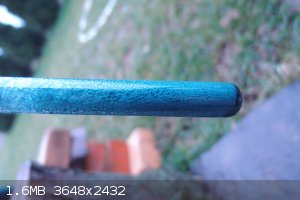 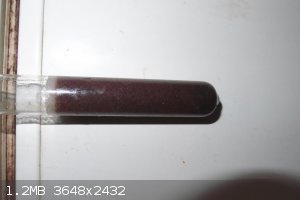 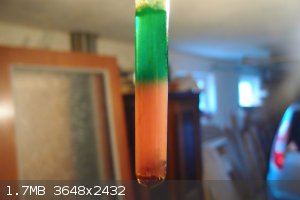 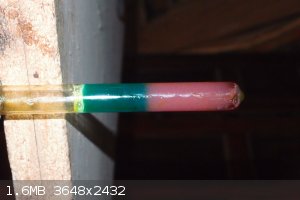 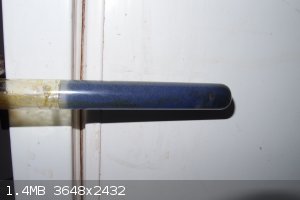
[Edited on 21-2-2016 by crystal grower]
|
|
|
elementcollector1
International Hazard
    
Posts: 2684
Registered: 28-12-2011
Location: The Known Universe
Member Is Offline
Mood: Molten
|
|
Honestly, I remember running into problems like this during my very first Nd extraction (a very long time ago). The true color of the 'magnet
chloride' is supposed to be an incredibly dark purple, and I've only once seen intermediate colors like these (and even then, that was after I boiled
down to crystals, which were really a mushy substance that kept changing color between green, blue, purple, etc.).
As for the simplest way of separating iron and neodymium, a good choice is oxalic acid (wood bleach). Add this and some sodium hydroxide to the
'magnet chloride', and the iron will chelate into solution as sodium ferrioxalate, forming a light green solution of Fe2+, while the
neodymium crashes out of solution as neodymium oxalate (a pink solid). From there, it can be gently calcined (to gray, if it turns white it becomes
basically inert) and redissolved in a very strong acid mixture (something like aqua regia, maybe, or hot sulfuric acid).
Elements Collected:52/87
Latest Acquired: Cl
Next in Line: Nd
|
|
|
crystal grower
Hazard to Others
  
Posts: 474
Registered: 3-1-2016
Location: Os Petrosum
Member Is Offline
Mood: Puzzled
|
|
Thanks for super procedure.
|
|
|
crystal grower
Hazard to Others
  
Posts: 474
Registered: 3-1-2016
Location: Os Petrosum
Member Is Offline
Mood: Puzzled
|
|
Awesome pic of my bismuth crystal   . .
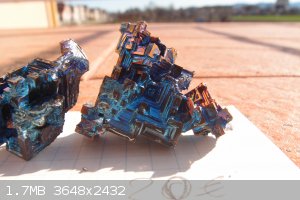
|
|
|
alexleyenda
Hazard to Others
  
Posts: 277
Registered: 17-12-2013
Location: Québec, Canada
Member Is Offline
Mood: Busy studying chemistry at the University
|
|
What is your trick to make great cristals like that? I made a bismuth cristal as great as this one once after many tries, but I don't know what I did
and i'm not able to do it again x)
Help us build the Sciencemadness Wiki! Every question and tips about amateur chemistry two clicks away, wouldn't that be awesome?!
sciencemadness.org/smwiki
|
|
|
crystal grower
Hazard to Others
  
Posts: 474
Registered: 3-1-2016
Location: Os Petrosum
Member Is Offline
Mood: Puzzled
|
|
hmmmm......
In fact I made this one a year ago and... now it seems i can´t make so pretty crystal again for some reason . .
Maybe I have contamined bismuth with something or its some curse of bismuth   . .
I will probably buy some new ingot and try it again. If it will be a success, I will tell u more.
|
|
|
Metacelsus
International Hazard
    
Posts: 2531
Registered: 26-12-2012
Location: Boston, MA
Member Is Offline
Mood: Double, double, toil and trouble
|
|
Although I haven't done any home chemistry in months, I've been working in an organic chemistry research lab, synthesizing highly conjugated compounds
that have potential use in OLEDs. Here are some pretty pictures involving my first such compound:
Workup of a Cadiot-Chodkiewicz coupling (aqueous layer on top, product dissolved in DCM)
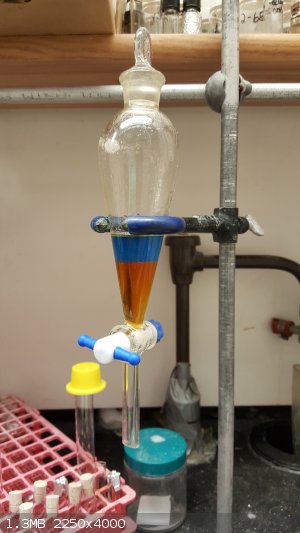
TLC spot of product fluorescing under longwave UV (this is a good sign).
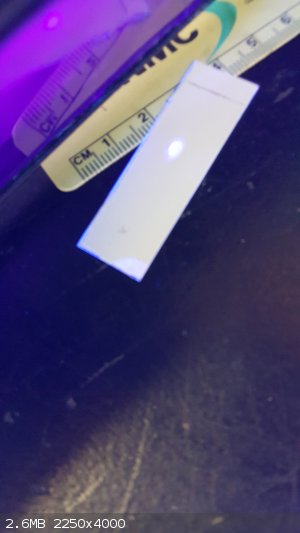
[Edited on 2-23-2016 by Metacelsus]
|
|
|
j_sum1
Administrator
       
Posts: 6218
Registered: 4-10-2014
Location: Unmoved
Member Is Offline
Mood: Organised
|
|
Details in my recent post in the When chemistry goes wrong thread.
The coppery stuff is what remains of a brass spoon. The bubbles were kind of sparkly looking and were chlorine. The purple is the copper-sodium
dichlorocyanurate complex. (Interesting that Na-DCCA was not one of my starting compounds.)
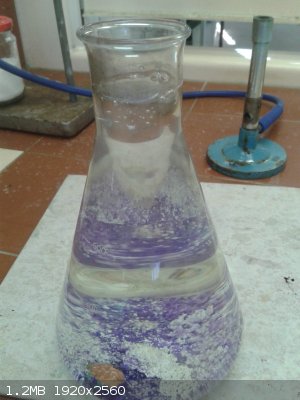 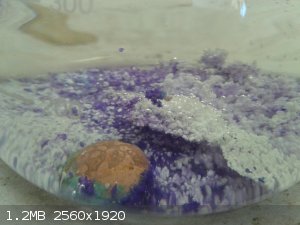
|
|
|
crystal grower
Hazard to Others
  
Posts: 474
Registered: 3-1-2016
Location: Os Petrosum
Member Is Offline
Mood: Puzzled
|
|
Analcime, chabazite from mindat
That's really awesome.
link:
http://www.mindat.org/photo-160295.html
[Edited on 24-2-2016 by crystal grower]

|
|
|
Hegi
Hazard to Others
  
Posts: 199
Registered: 27-9-2013
Member Is Offline
Mood: No idea.
|
|
Indigo
Hi guys,
recently I´ve prepared indigo and did some vat dyeing for fun at the university (actually one of the labs  ) ) Thanks everyone for visiting my web! INDIGO PREPARATION ) ) Thanks everyone for visiting my web! INDIGO PREPARATION
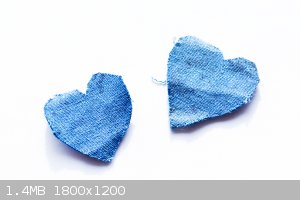
|
|
|
Texium
Administrator
       
Posts: 4508
Registered: 11-1-2014
Location: Salt Lake City
Member Is Offline
Mood: PhD candidate!
|
|
Nice! I'm actually currently working on an indigo synthesis too, however I'm actually synthesizing my own 2-nitrobenzaldehyde, so it's a more lengthy
procedure. I have 2-nitrotoluene now, and I'm currently awaiting the arrival of the solvent that I need for the oxidation step. Then it should be
smooth sailing from there. A writeup will be posted once I am finished. 
|
|
|
Hegi
Hazard to Others
  
Posts: 199
Registered: 27-9-2013
Member Is Offline
Mood: No idea.
|
|
Quote: Originally posted by zts16  | Nice! I'm actually currently working on an indigo synthesis too, however I'm actually synthesizing my own 2-nitrobenzaldehyde, so it's a more lengthy
procedure. I have 2-nitrotoluene now, and I'm currently awaiting the arrival of the solvent that I need for the oxidation step. Then it should be
smooth sailing from there. A writeup will be posted once I am finished. 
|
Oh man, such a long way. The last step is really smooth sailing besides making your own 2-nitrobenzaldehyde. Did you prepare 2-nitrotoluene?
|
|
|
| Pages:
1
..
42
43
44
45
46
..
76 |